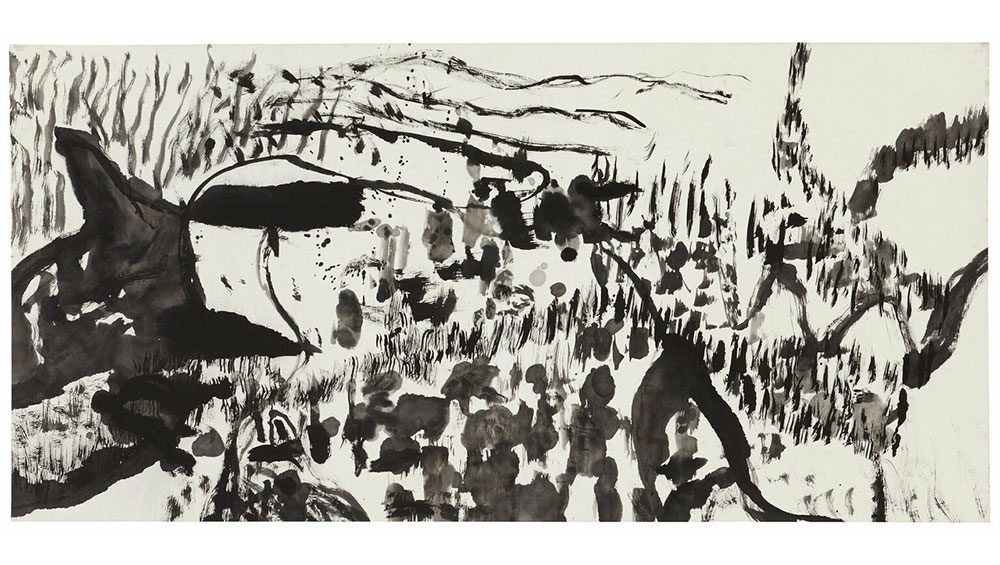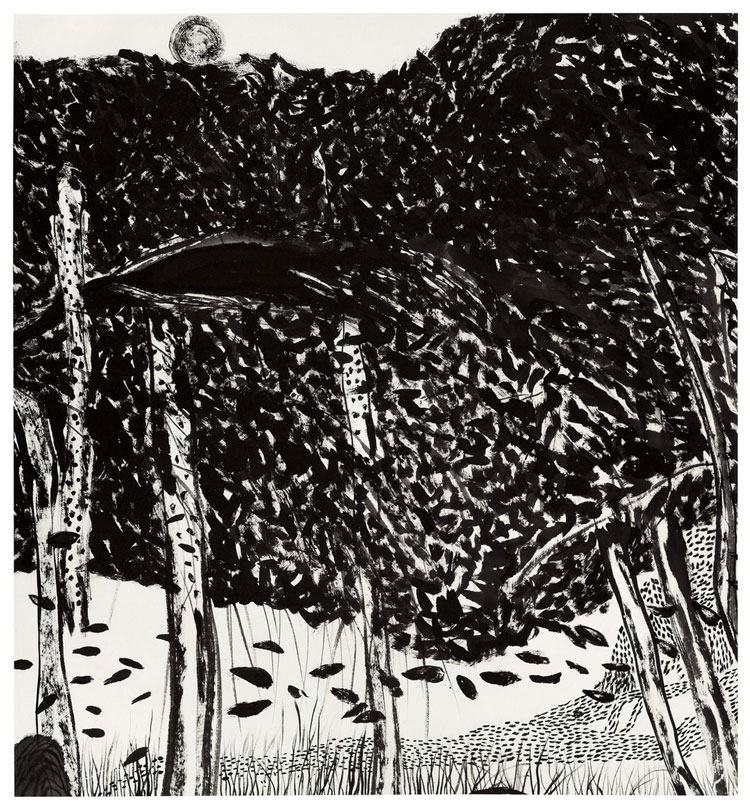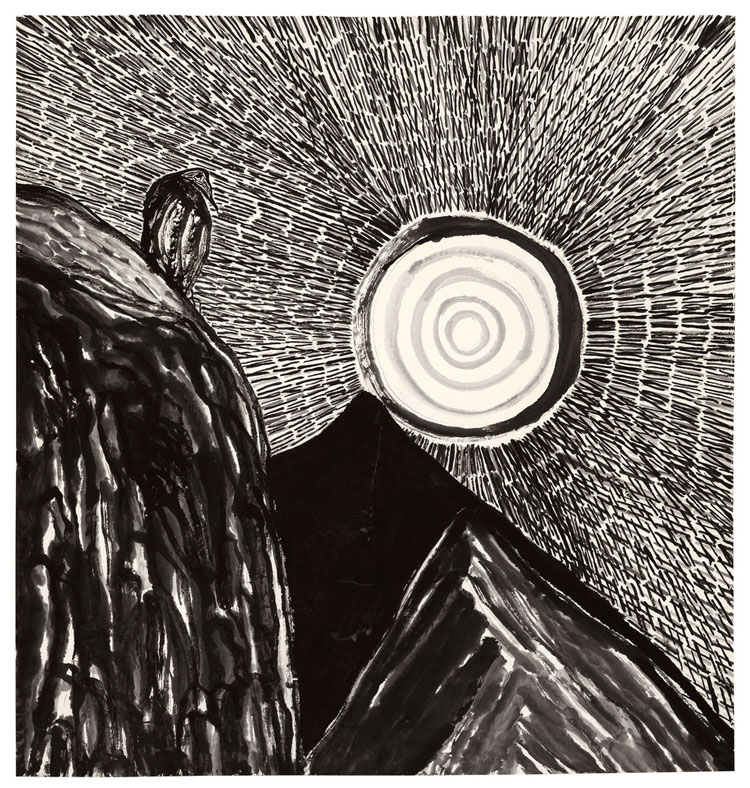
Matthew Wong, Untitled, 2014. Ink on rice paper. 31 x 57 1/2 in (78.7 x 146.1 cm). ©2021 Matthew Wong Foundation / Artists Rights Society (ARS), New York. Photography: Alex Yudzon / Cheim & Read, New York.
Cheim & Read, New York
5 May – 3 September 2021
by LILLY WEI
The Chinese Canadian artist Matthew Wong, who seemed to appear out of nowhere, streaked like a supernova over the art world in March 2018. It was the date of his first US solo show, at Karma in New York’s Lower East Side, and the reviews were rapturous. His second solo, Matthew Wong: Blue, also at Karma, in November 2019, was even more spectacular, several critics anointing him among the best of his generation of artists. By then, the artist was dead, at the age of 35. Wong, who had autism, Tourette syndrome and depression, had killed himself a month earlier, in his hometown of Edmonton, Canada.

Matthew Wong, Footprints in the Wind, 2016. Ink on rice paper. 38 x 35 in (96.5 x 88.9 cm). ©2021 Matthew Wong Foundation / Artists Rights Society (ARS), New York. Photo: Alex Yudzon / Cheim & Read, New York.
Matthew Wong: Footprints in the Wind, Ink Drawings 2013-2017, at Cheim & Read in Chelsea, New York, offers us another equally riveting exhibition from this singular artist’s complex, unsettling, prodigious oeuvre. Consisting of two dozen drawings – or paintings – it includes some of his earliest artistic endeavours. The works, black ink on white rice paper, are stripped of the intoxicating colours that characterised his two previous ventures and made them so alluring. But many of the themes are repeated, in ways that are even more visceral, the bared imagery gripping in its starkness and portentous charisma, the nuanced blacks as bewitching as a full palette, even if slower to register. Some of the works tilt towards abstraction, some towards representation, some arc between both modes in the same drawing, but even when clearly landscapes, precisely what we are looking at is not always certain.

Matthew Wong, The Performance, 2017, ink on rice paper, 34 1/2 x 28 in. ©2021 Matthew Wong Foundation / Artists Rights Society (ARS), New York. Photo: Alex Yudzon / Cheim & Read, New York.
The death of a young and talented artist is especially tragic and glosses the work with an additional intensity. Who does not know about Vincent van Gogh’s sad end? Indeed, Wong’s work has often been compared to that of the Dutch painter, as well as to that of Edvard Munch, Georges Seurat, Édouard Vuillard, Chinese ink painters and numerous other artists, evidence of his extensive study of art history. He avidly sought out painters and their works online, using social media to connect with them and other members of the artworld. He saw his work, he said, as a conversation with painters, contemporary and historical. While Shitao and Bada Shanren, revered Ming Dynasty painters, as well as other Chinese ink painters, were important influences, he was deeply interested in innumerable other artists’ works as well, taking what he needed, as artists have done since time out of mind.
Wong was born in 1984 in Toronto and graduated from the University of Michigan in 2007, earning a BA in cultural anthropology. He then went back to Hong Kong. Two years later, he took a photo of a still life, the “first creative thing I ever did”, he said in a 2014 interview in the online magazine Altermodernist. On the impetus of that, he enrolled in the City University of Hong Kong School of Creative Media to study photography and digital media, graduating with an MFA in 2013. He lived in Zhongshan from 2013-2015 and returned to Edmonton in 2016.

Matthew Wong, The Watcher, 2017. Ink on rice paper. 43 3/4 x 42 in (111.1 x 106.7 cm). ©2021 Matthew Wong Foundation / Artists Rights Society (ARS), New York. Photography: Alex Yudzon / Cheim & Read, New York.
It was in Zhongshan that he began to draw with paper and ink, “making a mess,” he said, self-deprecatingly. Soon, creating an ink drawing every morning became an existential ritual. Wholly absorbed, he taught himself to paint, swiftly finding his own voice and evolving a pictorial language of astonishingly expressive force in a mere handful of years.
The earliest work in the show is from 2013, an untitled horizontal abstraction that might be read as a forbidding, even apocalyptic landscape, the black ink poured, pooled, overlapping, brushed, evocatively modulated, followed by two drawings from 2014, one a grid, the other more distinctively a landscape, the ink daubed, dragged, applied both wet and dry, techniques that characterised Wong’s production throughout. The preponderance of works is from 2015 and 2016, and becomes increasingly narrative, more legible as landscape, the surface often divided between a kind of foreground, middle ground and background, although spatial positioning and scale is often distorted, enigmatic, shifting, entangled. The ground shudders with impressionistic, almost pointillistic marks that take on a life of their own, skittering across the surface restlessly. Circles, spirals and swirls interloop, sometimes enclosing single figures, sometimes tenderly embedding a mother and child within them. Forms might be silhouetted, blurred or crisply delineated at the edges. They are also fluid; the demarcation between what might be human, what might be landscape or nature ambiguous, the decoding of imagery often left to the viewer’s suppositions.

Matthew Wong, Winter Wind, 2016. Ink on rice paper. 31 3/4 x 27 1/8 in (80.6 x 68.9 cm). ©2021 Matthew Wong Foundation / Artists Rights Society (ARS), New York. Photography: Alex Yudzon / Cheim & Read, New York.
A Poet’s World (2015) – Wong was now adding titles – is a vertical painting that is more than 1.5 metres (5ft) tall, focused on what might be a figure in profile, or not, holding a book, or something else, its head, if it is a head, outlined, contoured with quick, short lines, devoid of features except for a small black dot for an eye, maybe, the background densely patterned, suggesting a grove of trees, or an abstraction. Snowfall (2015), another vertical work, is bisected by a figure in black, its shroud-like robe composed of countless little wriggling lines. The ground is blizzarded by splatters, drips, a black snow instead of white, and ballasting the right side are two outsized coniferous stalks, or so they seem, the pine a symbol of longevity in Chinese iconography. Other works are similarly mysterious, such as a head crisscrossed by black bands, again with one dot/eye visible. Several titles have celestial references, such as Heaven and Earth (2015) and Stargazing (2015), while the show’s title work, Footprints in the Wind (2016) depicts an empty path covered in footprints skirting a forest of thick, accumulated brushstrokes. The winding path is a signature motif, evoking a common dream most of us have had in which we are lost, searching anxiously, desperately for the way forward, searching for something, for someone.
In Where Did the Time Go? (2016), a crosshatched surface surrounds an oval that might be a positive or negative form: a portal, a sun, or an egg, à la Brâncuși, while The Sun (2016) and The Watcher (2017), with their concentric radiating circles, shimmer with ecstatic cosmic ferocity, and Valley for Picabia (2017) and Landscape with Bather (2017) credits some of his other heroes. Odyssey (2017) is a variant on the theme of the endless road, the wanderer, the outsider, the precarious journey through a threatening Dantesque “forest dark”, the “straightforward pathway” lost. Wong destabilises the road with short repetitive dashes as it plunges into the picture plane, vanishing. His works might also remind us that, on Earth, we’re briefly gorgeous, in the poignant words of the Vietnamese poet and novelist Ocean Vuong.